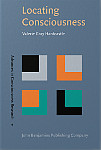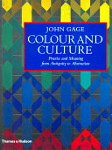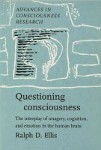Books on consciousness
A list of books relating to the hard problem of consciousness. Regularly updated cos I keep finding new stuff all the time.
A list of books relating to the hard problem of consciousness. Regularly updated cos I keep finding new stuff all the time.
1995
 Bermúdez, Marcel & Eilan (eds.)
Bermúdez, Marcel & Eilan (eds.)
The Body and the Self
(MIT 1995)
This volume brings together recent work by philosophers and psychologists on the nature of self-consciousness, the nature of bodily awareness, and the relation between the two. How is our grasp of ourselves as one object among others underpinned by the ways in which we use and represent our bodies? This is the central question addressed in this volume. See MIT | Amazon | Google
 Peter Baumgartner & Sabine Payr (eds.)
Peter Baumgartner & Sabine Payr (eds.)
Speaking Minds: Interviews with Twenty Eminent Cognitive Scientists
(Princeton 1995)
The attempt to engineer human-like intelligence by artificial means has sparked a continuing debate among psychologists, neuroscientists, philosophers,and linguists. In the twenty substantial interviews published here, leading researchers address vexing questions in the field of cognitive science. See Princeton | Amazon | Google | Internet Archive
 Sergio Moravia
Sergio Moravia
The Enigma of the Mind: The Mind-Body Problem in Contemporary Thought
(Cambridge 1995, trans. Scott Staton)
A broad and lucid critical and historical survey of one of the fundamental debates in the philosophy of mind. The book has two central aims. First, Professor Moravia sketches the major recent contributions to the mind-body problem from philosophers of mind. Having established this framework Professor Moravia pursues his second aim – the articulation of a particular interpretation of the mental and the mind-body problem. See Cambridge | Amazon | Google
 Valerie Gray Hardcastle
Valerie Gray Hardcastle
Locating Consciousness
(John Benjamins 1995)
Hardcastle argues that our qualitative experiences should be aligned with the activity of a single and distinct memory system in our mind/brain. Spelling out in detail what we do and do not know about phenomenological experience, this book denies the common view of consciousness as a central decision-making system. Instead, consciousness is viewed as a lower level dynamical structure underpinning our information processing. Drawing on recent data in psychology and neuroscience, she also discusses when we become conscious and when we should think other animals are conscious. See John Benjamins | Amazon | Google
 Leen Spruit
Leen Spruit
Species Intelligibilis: From Perception to Knowledge. Vol. 2. Renaissance Controversies, Later Scholasticism, and the Elimination of the Intelligible Species in Modern Philosophy
(Brill 1995)
Following the discussion of volume 1 (1994), this volume examines Renaissance controversies over Thomas Aquinas’s doctrine of intelligible species, discussing Peripatetics, Neoplatonics, and a group of relatively independent authors. Developments of late Scholasticism, and the elimination of the intelligible species in modern non-Aristotelian philosophy are then scrutinized. Particular attention is paid to the possible roots of the seventeenth-century theories of ideas in traditional philosophy. See Brill | Amazon | Google
 Paul M. Churchland
Paul M. Churchland
The Engine of Reason, the Seat of the Soul: A Philosophical Journey Into the Brain
(MIT 1995)
A new picture of the mind is emerging, and explanations now exist for what has so long seemed mysterious. Churchland explains these scientific developments in a simple, authoritative, and pictorial fashion. Opening the door into the ongoing research of the neurobiological and connectionist communities, he suggests a unified set of answers to questions about how the brain actually works, how it sustains a thinking, feeling, dreaming self, and how it sustains a self-conscious person. See Amazon | Google
 Alwyn Scott
Alwyn Scott
Stairway to the Mind: The Controversial New Science of Consciousness
(Springer 1995)
Consciousness has perplexed philosophers, artists and scientists for centuries. Some think it is purely physical, while others believe it transcends the material world. Scott offers a new perspective, based entirely on evidence from the natural sciences, whereby materialism and dualism co-exist. He proposes a hierarchical view of mental organization; a stairway. Atoms give rise to molecules, neurons form the brain and individual consciousness leads to shared culture. See Springer | Amazon | Google
 Harry T. Hunt
Harry T. Hunt
On the Nature of Consciousness: Cognitive, Phenomenological, and Transpersonal Perspectives
(Yale 1995)
What is the relation between mystical experience and ordinary consciousness, between the principles of modern physics and the patterns of perception in all moving creatures, between our human self-consciousness and the primary sentience of protozoa? This book pursues an inquiry into consciousness that ranges from ancient Greece to empirical neuro-psychology to the experiential traditions of introspection and meditation. See Yale | Google
 John Gage
John Gage
Colour and Culture
(Thames & Hudson 1995)
A book of extraordinary discussions on a wide range of issues – Greek colour theory, mosaics, stained glass, heraldry, the rainbow, drawing versus colorito in Venetian painting, colour vocabulary, Newtonian optics, Goethe’s colour theories, the chemistry of pigments, efforts to correlate colours with sounds, the role of colour in abstract painting, and much, much more. Winner of the Mitchell Prize for the History of Art. See Thames & Hudson | Google
 Fred Dretske
Fred Dretske
Naturalizing the Mind
(MIT 1995)
Dretske develops a representational theory of the phenomenal aspects of the mind that have defied traditional forms of naturalism. For Dretske, the phenomenal aspects of perceptual experiences are one and the same as external, real-world properties that experience represents objects as having. Combined with an evolutionary account of sensory representation, the result is a naturalistic account of phenomenal consciousness. See MIT Press | Google
 Thomas Metzinger (ed.)
Thomas Metzinger (ed.)
Conscious Experience
(Imprint 1995)
A series of original articles, representing a cross-section of philosophical work on consciousness – “The best concerted voice to date from the philosophers’ camp.” Includes a bibliography on consciousness in philosophy, cognitive science and brain research, covering the last 25 years and consisting of over 1000 entries in 18 thematic sections, compiled by David Chalmers and Thomas Metzinger. See Imprint and Imprint again | Amazon | Google Books
 Michael Tye
Michael Tye
Ten Problems of Consciousness
(MIT 1995)
Michael Tye formulates a new and enlightening theory about the phenomenal “what it feels like” aspect of consciousness. The test of any such theory, according to Tye, lies in how well it handles ten critical problems of consciousness. He argues that all experiences and all feelings represent things, and that their phenomenal aspects are to be understood in terms of what they represent. See MIT | Google | Amazon
 Evan Thompson
Evan Thompson
Colour Vision: A Study in Cognitive Science and the Philosophy of Perception
(Routledge 1995)
Thompson provides an accessible review of the current scientific and philosophical discussions of colour vision and steers a course between the subjective and objective positions on colour, arguing for a relational account. This account develops a novel “ecological” approach to colour vision in cognitive science and the philosophy of perception. See Routledge | Google | Amazon
 Arthur Zajonc
Arthur Zajonc
Catching the Light: The Entwined History of Light and Mind
(Oxford 1995)
In 1910, the surgeons Moreau and LePrince wrote about their successful operation on an eight-year-old boy who had been blind since birth because of cataracts. When the boy’s eyes were healed they removed the bandages and, waving a hand in front of the child’s physically perfect eyes, asked him what he saw. “I don’t know,” was his only reply. Light and eyes were not enough to grant him sight. How then do we see? What’s the difference between seeing and perception? What is light? See Oxford | Google | Amazon
 Barry Maund
Barry Maund
Colours - Their Nature and Representation
(Cambridge 1995)
The world as we experience it is full of colour. This book defends the radical thesis that no physical object has any of the colours we experience it as having. The author provides a unified account of colour that shows why we experience the illusion and why the illusion is not to be dispelled but welcomed. See Cambridge U Press | Google
 Ralph D. Ellis
Ralph D. Ellis
Questioning Consciousness: The Interplay of Imagery, Cognition, and Emotion in the Human Brain
(John Benjamins 1995)
Combining neuroscientific, psychological and phenomenological research, Ellis argues that to be conscious of an object is essentially to imagine in a habituated way what would happen if we were to perform certain actions in relation to the object; and that mental images fit together to build up abstract concepts. This analysis shows why conscious information processing is so structurally different from, yet interrelated with, non-conscious processing. See John Benjamins | Google

The Body and the Self
(MIT 1995)
This volume brings together recent work by philosophers and psychologists on the nature of self-consciousness, the nature of bodily awareness, and the relation between the two. How is our grasp of ourselves as one object among others underpinned by the ways in which we use and represent our bodies? This is the central question addressed in this volume. See MIT | Amazon | Google

Speaking Minds: Interviews with Twenty Eminent Cognitive Scientists
(Princeton 1995)
The attempt to engineer human-like intelligence by artificial means has sparked a continuing debate among psychologists, neuroscientists, philosophers,and linguists. In the twenty substantial interviews published here, leading researchers address vexing questions in the field of cognitive science. See Princeton | Amazon | Google | Internet Archive

The Enigma of the Mind: The Mind-Body Problem in Contemporary Thought
(Cambridge 1995, trans. Scott Staton)
A broad and lucid critical and historical survey of one of the fundamental debates in the philosophy of mind. The book has two central aims. First, Professor Moravia sketches the major recent contributions to the mind-body problem from philosophers of mind. Having established this framework Professor Moravia pursues his second aim – the articulation of a particular interpretation of the mental and the mind-body problem. See Cambridge | Amazon | Google

Locating Consciousness
(John Benjamins 1995)
Hardcastle argues that our qualitative experiences should be aligned with the activity of a single and distinct memory system in our mind/brain. Spelling out in detail what we do and do not know about phenomenological experience, this book denies the common view of consciousness as a central decision-making system. Instead, consciousness is viewed as a lower level dynamical structure underpinning our information processing. Drawing on recent data in psychology and neuroscience, she also discusses when we become conscious and when we should think other animals are conscious. See John Benjamins | Amazon | Google

Species Intelligibilis: From Perception to Knowledge. Vol. 2. Renaissance Controversies, Later Scholasticism, and the Elimination of the Intelligible Species in Modern Philosophy
(Brill 1995)
Following the discussion of volume 1 (1994), this volume examines Renaissance controversies over Thomas Aquinas’s doctrine of intelligible species, discussing Peripatetics, Neoplatonics, and a group of relatively independent authors. Developments of late Scholasticism, and the elimination of the intelligible species in modern non-Aristotelian philosophy are then scrutinized. Particular attention is paid to the possible roots of the seventeenth-century theories of ideas in traditional philosophy. See Brill | Amazon | Google

The Engine of Reason, the Seat of the Soul: A Philosophical Journey Into the Brain
(MIT 1995)

A new picture of the mind is emerging, and explanations now exist for what has so long seemed mysterious. Churchland explains these scientific developments in a simple, authoritative, and pictorial fashion. Opening the door into the ongoing research of the neurobiological and connectionist communities, he suggests a unified set of answers to questions about how the brain actually works, how it sustains a thinking, feeling, dreaming self, and how it sustains a self-conscious person. See Amazon | Google

Stairway to the Mind: The Controversial New Science of Consciousness
(Springer 1995)
Consciousness has perplexed philosophers, artists and scientists for centuries. Some think it is purely physical, while others believe it transcends the material world. Scott offers a new perspective, based entirely on evidence from the natural sciences, whereby materialism and dualism co-exist. He proposes a hierarchical view of mental organization; a stairway. Atoms give rise to molecules, neurons form the brain and individual consciousness leads to shared culture. See Springer | Amazon | Google

On the Nature of Consciousness: Cognitive, Phenomenological, and Transpersonal Perspectives
(Yale 1995)
What is the relation between mystical experience and ordinary consciousness, between the principles of modern physics and the patterns of perception in all moving creatures, between our human self-consciousness and the primary sentience of protozoa? This book pursues an inquiry into consciousness that ranges from ancient Greece to empirical neuro-psychology to the experiential traditions of introspection and meditation. See Yale | Google

Colour and Culture
(Thames & Hudson 1995)
A book of extraordinary discussions on a wide range of issues – Greek colour theory, mosaics, stained glass, heraldry, the rainbow, drawing versus colorito in Venetian painting, colour vocabulary, Newtonian optics, Goethe’s colour theories, the chemistry of pigments, efforts to correlate colours with sounds, the role of colour in abstract painting, and much, much more. Winner of the Mitchell Prize for the History of Art. See Thames & Hudson | Google

Naturalizing the Mind
(MIT 1995)

Dretske develops a representational theory of the phenomenal aspects of the mind that have defied traditional forms of naturalism. For Dretske, the phenomenal aspects of perceptual experiences are one and the same as external, real-world properties that experience represents objects as having. Combined with an evolutionary account of sensory representation, the result is a naturalistic account of phenomenal consciousness. See MIT Press | Google

Conscious Experience
(Imprint 1995)
A series of original articles, representing a cross-section of philosophical work on consciousness – “The best concerted voice to date from the philosophers’ camp.” Includes a bibliography on consciousness in philosophy, cognitive science and brain research, covering the last 25 years and consisting of over 1000 entries in 18 thematic sections, compiled by David Chalmers and Thomas Metzinger. See Imprint and Imprint again | Amazon | Google Books

Ten Problems of Consciousness
(MIT 1995)

Michael Tye formulates a new and enlightening theory about the phenomenal “what it feels like” aspect of consciousness. The test of any such theory, according to Tye, lies in how well it handles ten critical problems of consciousness. He argues that all experiences and all feelings represent things, and that their phenomenal aspects are to be understood in terms of what they represent. See MIT | Google | Amazon

Colour Vision: A Study in Cognitive Science and the Philosophy of Perception
(Routledge 1995)
Thompson provides an accessible review of the current scientific and philosophical discussions of colour vision and steers a course between the subjective and objective positions on colour, arguing for a relational account. This account develops a novel “ecological” approach to colour vision in cognitive science and the philosophy of perception. See Routledge | Google | Amazon

Catching the Light: The Entwined History of Light and Mind
(Oxford 1995)
In 1910, the surgeons Moreau and LePrince wrote about their successful operation on an eight-year-old boy who had been blind since birth because of cataracts. When the boy’s eyes were healed they removed the bandages and, waving a hand in front of the child’s physically perfect eyes, asked him what he saw. “I don’t know,” was his only reply. Light and eyes were not enough to grant him sight. How then do we see? What’s the difference between seeing and perception? What is light? See Oxford | Google | Amazon

Colours - Their Nature and Representation
(Cambridge 1995)
The world as we experience it is full of colour. This book defends the radical thesis that no physical object has any of the colours we experience it as having. The author provides a unified account of colour that shows why we experience the illusion and why the illusion is not to be dispelled but welcomed. See Cambridge U Press | Google

Questioning Consciousness: The Interplay of Imagery, Cognition, and Emotion in the Human Brain
(John Benjamins 1995)
Combining neuroscientific, psychological and phenomenological research, Ellis argues that to be conscious of an object is essentially to imagine in a habituated way what would happen if we were to perform certain actions in relation to the object; and that mental images fit together to build up abstract concepts. This analysis shows why conscious information processing is so structurally different from, yet interrelated with, non-conscious processing. See John Benjamins | Google
Menu
 What’s a logical paradox?
What’s a logical paradox? Achilles & the tortoise
Achilles & the tortoise The surprise exam
The surprise exam Newcomb’s problem
Newcomb’s problem Newcomb’s problem (sassy version)
Newcomb’s problem (sassy version) Seeing and being
Seeing and being Logic test!
Logic test! Philosophers say the strangest things
Philosophers say the strangest things Favourite puzzles
Favourite puzzles Books on consciousness
Books on consciousness Philosophy videos
Philosophy videos Phinteresting
Phinteresting Philosopher biographies
Philosopher biographies Philosopher birthdays
Philosopher birthdays Draft
Draftbarang 2009-2024  wayback machine
wayback machine
 wayback machine
wayback machine